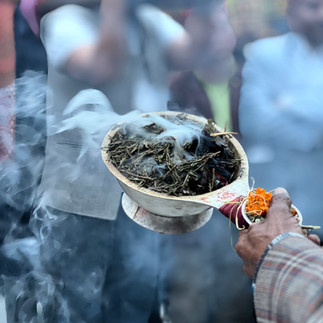When Gods Walk With People: The Living Devta Traditions of Himachal Pradesh
- Apr 28
- 3 min read
— and how the melas that surround them keep communities together

In Himachal Pradesh, the divine doesn’t sit atop unreachable peaks — it walks the same dusty roads as its people. Here, gods don’t belong to mythology alone. They live among the villagers, are consulted like elders, celebrated like kin, and carried on the shoulders of those who love and fear them in equal measure.
These are the devtas of Himachal — not symbolic deities, but living, breathing presences. Each village often has its own devta, housed in elaborately carved wooden temples and cared for by appointed caretakers, musicians, and oracles. These gods are believed to be active, responding to village affairs, offering protection, and even settling disputes.
But what makes this tradition unique isn’t just its depth of belief — it’s how deeply intertwined it is with the rhythm of community life.
The Story of Vashisht Devta: A Village in Conversation With Its Guardian
In the village of Vashisht, just across the river from Manali, the temple of Vashisht Devta sits quietly amid narrow stone alleys and hot springs. While tourists bathe in the sulphur pools, many are unaware that they’re in the presence of a deeply revered devta, associated with the sage Vashishta from the Ramayana.
Locals believe this devta watches over the valley — not just spiritually, but practically. When a major decision is to be made, the devta is consulted. Oracles — known locally as gurs — enter trance-like states during ceremonies to voice the devta’s will. Offerings are made. Processions are held. And when the devta “decides” to visit neighboring villages, it’s not a casual trip. It’s an event.
Melas: Where the Sacred Meets the Social
These divine journeys give birth to melas — traditional fairs built around the devta’s visit. These are not mere festivals. They are full-scale cultural gatherings that combine ritual with revelry, storytelling with trade, devotion with dance.
The devta is carried in a wooden palanquin, draped in bright fabrics, silver masks, and garlands. He arrives to the sound of nagara drums and the haunting call of the ransingha horn. People gather in thousands — dressed in traditional woolens, often having walked miles — to greet him.
There’s dancing, known as nati, where entire villages sway in synchronized rhythm. There are rituals, food stalls, storytellers, matchmakers, and justice seekers. At many melas, devtas from other villages are “invited,” leading to an incredible spectacle — a congregation of gods, each with their own following, each bringing their own energy to the gathering.
But beyond the spectacle, the mela serves a purpose deeply human:
It breaks isolation in a land where winter shuts down entire regions.
It renews ties between neighboring villages.
It provides a space for grievances to be addressed under the spiritual supervision of the devta.
It passes down oral histories, traditions, and rituals to the next generation.
A Living System, Not a Frozen Past
What’s most remarkable about Himachal’s devta system is that it’s not a remnant of the past. It lives, adapts, and breathes. While modernity creeps in — with mobile towers replacing pine trees and resorts redefining landscapes — the devta still holds authority. The local governance system often bends to its decisions. Faith is not decorative here; it’s infrastructural.
And yet, this culture remains undocumented in mainstream narratives. Tourists flock to Himachal for its treks, cafés, and snow-covered selfies — missing entirely the layered cosmology that surrounds them.
Perhaps it’s time we listen more carefully. In the beat of the drums, in the quiet of a temple courtyard, in the sway of villagers dancing arm in arm — the devtas are still speaking.
Not from some ancient throne, but from the heart of the people who carry them.















Comments